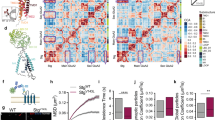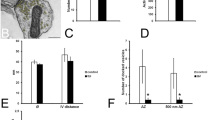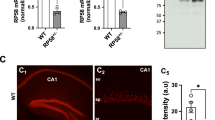Abstract
Tambaleante (tbl/tbl) is a mutant mouse that carries a spontaneous Gly483Glu substitution in the HERC1 (HECT domain and RCC1 domain) E3 ubiquitin ligase protein (HERC1). The tbl/tbl mutant suffers an ataxic syndrome given the almost complete loss of cerebellar Purkinje cells during adult life. More recent analyses have identified alterations at neuromuscular junctions in these mice, as well as in other neurons of the central nervous system, such as motor neurons in the spinal cord, or pyramidal neurons in the hippocampal CA3 region and the neocortex. Accordingly, the effect of the tbl/tbl mutation apparently extends to other regions of the nervous system far from the cerebellum. As HERC1 mutations in humans have been correlated with intellectual impairment, we studied the effect of the tbl/tbl mutation on learning. Using a behavioral test, ex vivo electrophysiological recordings, immunohistochemistry, and Golgi method, we analyzed the associative learning in the lateral amygdala of the tbl/tbl mouse. The tbl/tbl mice perform worse than wild-type animals in the passive avoidance test, and histologically, the tbl/tbl mice have more immature forms of dendritic spines. In addition, LTP cannot be detected in these animals and their STP is dampened, as is their glutamatergic input to the lateral amygdala. Together, these data suggest that HERC1 is probably involved in regulating synaptic function in the amygdala. Indeed, these results indicate that the tbl/tbl mutation is a good model to analyze the effect of alterations to the ubiquitin–proteasome pathway on the synaptic mechanisms involved in learning and its defects.





Similar content being viewed by others
References
Hegde AN, Upadhya SC (2007) The ubiquitin-proteasome pathway in health and disease of the nervous system. Trends Neurosci 30:587–595
van Tijn P, Hol EM, van Leeuwen FW, Fischer DF (2008) The neuronal ubiquitin-proteasome system: murine models and their neurological phenotype. Prog Neurobiol 85:76–193
de Vrij FM, Fischer DF, van Leeuwen FW, Hol EM (2004) Protein quality control in Alzheimer’s disease by the ubiquitin proteasome system. Prog Neurobiol 74:249–270
Upadhya SC, Hegde AN (2005) Ubiquitin-proteasome pathway components as therapeutic targets for CNS maladies. Curr Pharm Des 11:3807–3828
Rubinsztein DC (2006) The roles of intracellular protein-degradation pathways in neurodegeneration. Nature 443:780–786
van Tijn P, Dennissen FJ, Gentier RJ et al (2012) Mutant ubiquitin decreases amyloid beta plaque formation in a transgenic mouse model of Alzheimer’s disease. Neurochem Int 61:739–748
Rusmini P, Bolzoni E, Crippa V et al (2010) Proteasomal and autophagic degradative activities in spinal and bulbar muscular atrophy. Neurobiol Dis 40:361–369
Ramser J, Ahearn ME, Lenski C et al (2008) Rare missense and synonymous variants in UBE1 are associated with X-linked infantile spinal muscular atrophy. Am J Hum Genet 82:188–193
Deng HX, Chen W, Hong ST et al (2011) Mutations in UBQLN2 cause dominant X-linked juvenile and adult-onset ALS and ALS/dementia. Nature 477:211–215
Dlamini N, Josifova DJ, Paine SM et al (2013) Clinical and neuropathological features of X-linked spinal muscular atrophy (SMAX2) associated with a novel mutation in the UBA1 gene. Neuromuscul Disord 23:391–398
Nguyen LS, Schneider T, Rio M et al (2015) A nonsense Q4 variant in HERC1 is associated with intellectual disability, megalencephaly, thick corpus callosum and cerebellar atrophy. Eur J Hum Genet 24:455–458
Ortega-Recalde O, Beltrán OI, Gálvez JM, Palma-Montero A, Restrepo CM, Mateus HE, Laissue P (2015) Biallelic HERC1 mutations in a syndromic form of overgrowth and intellectual disability. Clin Genet. doi:10.1111/cge.12634
Aggarwal S, Bhowmik AD, Ramprasad VL, Murugan S, Dalal A (2016) A splice site mutation in HERC1 leads to syndromic intellectual disability with macrocephaly and facial dysmorphism: further delineation of the phenotypic spectrum. Am J Med Genet. doi:10.1002/ajmg.a.37654
Mashimo T, Hadjebi O, Amair-Pinedo F et al (2009) Progressive Purkinje cell degeneration in tambaleante mutant mice is a consequence of a missense mutation in HERC1 E3 ubiquitin ligase. PLoS Genet. doi:10.1371/journal.pgen.1000784
Wassef M, Sotelo C, Cholley B, Brehier A, Thomasset M (1987) Cerebellar mutations affecting the postnatal survival of Purkinje cells in the mouse disclose a longitudinal pattern of differentially sensitive cells. Dev Biol 124:379–389
Rossi F, Jankovski A, Sotelo C (1995) Target neuron controls the integrity of afferent axon phenotype: a study on the Purkinje cell-climbing fiber system in cerebellar mutant mice. J Neurosci 15:2040–2056
Dusart I, Guenet JL, Sotelo C (2006) Purkinje cell death: differences between developmental cell death and neurodegenerative death in mutant mice. Cerebellum 5:163–173
Ruiz R, Pérez-Villegas EM, Bachiller S, Rosa JL, Armengol JA (2016) HERC 1 ubiquitin ligase mutation affects neocortical, CA3 hippocampal and spinal cord projection neurons: an ultrastructural study. Front Neuroanat. doi:10.3389/fnana.2016.00042
Grüsser-Cornehls U, Bäurle J (2001) Mutant mice as a model for cerebellar ataxia. Prog Neurobiol 63:489–540
Porras-García ME, Ruiz R, Pérez-Villegas EM, Armengol JA (2013) Motor learning of mice lacking cerebellar Purkinje cells. Front Neuroanat. doi:10.3389/fnana. 2013.00004
Bachiller S, Rybkina T, Porras-García E et al (2015) The HERC1 E3 ubiquitin ligase is essential for normal development and for neurotransmission at the mouse neuromuscular junction. Cell Mol Life Sci 72:2961–2971
LeDoux JE (2000) Emotion circuits in the brain. Annu Rev Neurosci 23:155–184
Morrison SE, Salzman CD (2010) Re-valuing the amygdala. Curr Opin Neurobiol 20:221–230
Salzman CD, Fusi S (2010) Emotion, cognition, and mental state representation in amygdala and prefrontal cortex. Annu Rev Neurosci 33:173–202
De Olmos JS, Beltramino CA, Alheid G (2004) Amygdala and extended amygdala of the rat: a cytoarchitectonic, fibroarchitectonic and chemoarchitectonic survey. In: Paxinos G (ed) The rat nervous system, 3rd edn. Elsevier Academic Press, San Diego, pp. 509–603
LeDoux JE, Cicchetti P, Xagoraris A, Romanski LM (1990) The lateral amygdaloid nucleus: sensory interface of the amygdala in fear conditioning. J Neurosci 10:1062–1069
Medina JF, Repa JC, Mauk MD, LeDoux JE (2002) Parallels between cerebellum- and amygdala dependent conditioning. Nat Rev Neurosci 3:122–131
LeDoux J (2003) The emotional brain, fear and the amygdala. Cell Mol Neurobiol 23:727–738
Maren S, Quirk GJ (2004) Neuronal signalling of fear memory. Nat Rev Neurosci 5:844–852
Zhou Y, Won J, Karlsson G et al (2009) CREB regulates excitability and the allocation of memory to subsets of neurons in the amygdala. Nat Neurosci 12:1438–1443
Mitra R, Jadhav S, McEwen BS, Vyas A, Chattarji S (2005) Stress duration modulates the spatiotemporal patterns of spine formation in the basolateral amygdala. Proc Natl Acad Sci U S A 102:9371–9376
Heinrichs SC, Leite-Morris KA, Guy MD, Goldberg LR, Young AJ, Kaplan GB (2013) Dendritic structural plasticity in the basolateral amygdala after fear conditioning and its extinction in mice. Behav Brain Res 248:80–84
DeFelipe J (2015) The dendritic spine story: an intriguing process of discovery. Front Neuroanat. doi:10.3389/fnana.2015.00014
Yuste R, Tank DW (1996) Dendritic integration in mammalian neurons, a century after Cajal. Neuron 16:701–716
Yuste R, Bonhoeffer T (2001) Morphological changes in dendritic spines associated with long-term synaptic plasticity. Annu Rev Neurosci 24:1071–1089
Lamprecht R, LeDoux J (2004) Structural plasticity and memory. Nat Rev Neurosci 5:45–54
Yuste R (2013) Electrical compartmentalization in dendritic spines. Annu Rev Neurosci 36:429–449
Rogerson T, Cai DJ, Frank A, Sano Y, Shobe J, Lopez-Aranda MF, Silva AJ (2014) Synaptic tagging during memory allocation. Nat Rev Neurosci 15:157–169
Suárez-Pereira I, Canals S, Carrión AM (2015) Adult newborn neurons are involved in learning acquisition and long-term memory formation: the distinct demands on temporal neurogenesis of different cognitive tasks. Hippocampus 25:51–61
Musumeci G, Sciarretta C, Rodríguez-Moreno A et al (2009) TrkB modulates fear learning and amygdalar synaptic plasticity by specific docking sites. J Neurosci 29:10131–10143
Negrete-Díaz J-V, Duque-Feria P, Andrade-Talavera Y, Carrión M, Flores G, Rodríguez-Moreno A (2012) Kainate receptor-mediated depression of glutamatergic transmission involving protein kinase A in the lateral amygdala. J Neurochem 121:36–43
Weisskopf MG, Bauer EP, LeDoux JE (1999) L-type voltage-gated calcium channels mediate NMDA-independent associative long-term potentiation at thalamic input synapses to the amygdala. J Neurosci 19:10512–10519
DeFelipe J, Fairén A (1988) Synaptic connections of an interneuron with axonal arcades in the cat visual cortex. J Neurocytol 17:313–323
Risher WC, Ustunkaya T, Singh Alvarado J, Eroglu C (2014) Rapid Golgi analysis method for efficient and unbiased classification of dendritic spines. PLoS One. doi:10.1371/journal.pone.0107591
Cochin J (1968) Methods of the appraisal of analgesic drugs for addiction liability. In: Burger A (ed) Selected pharmacological testing methods. Marcel Dekker, New York, pp. 121–167
Romanski L-M, LeDoux J-E (1992) Equipotentiality of thalamo-amygdala and thalamo-cortico-amygdala circuits in auditory fear conditioning. J Neurosci 12:4501–4509
Campeau S, Davis M (1995) Involvement of subcortical and cortical afferents to the lateral nucleus of the amygdala in fear conditioning measured with fear-potentiated startle in rats trained concurrently with auditory and visual conditioned stimuli. J Neurosci 15:2312–2327
Rodrigues SM, Schafe GE, LeDoux JE (2004) Molecular mechanisms underlying emotional learning and memory in the lateral amygdala. Neuron 44:75–91
McDonald AJ (1982) Neurons of the lateral and basolateral amygdaloid nuclei: a Golgi study in the rat. J Comp Neurol 212:293–312
Morgan JT, Amaral DG (2014) Comparative analysis of the dendritic organization of principal neurons in the lateral and central nuclei of the rhesus macaque and rat amygdala. J Comp Neurol 522:689–716
Jiang L, Kundu S, Lederman JD et al (2016) Cholinergic signaling controls conditioned fear behaviors and enhances plasticity of cortical-amygdala circuits. Neuron 90:1–14
Maroun M, Ioannides PJ, Bergman KL, Kavushansky A, Holmes A, Wellman CL (2013) Fear extinction deficits following acute stress associate with increased spine density and dendritic retraction in basolateral amygdala neurons. Eur J Neurosci. doi:10.1111/ejn.12259
Huttenlocher PR (1974) Dendritic development in neocortex of children with mental defect and infantile spasms. Neurology 24:203–210
Purpura DP (1975) Normal and aberrant neuronal development in the cerebral cortex of human fetus and young infant. UCLA Forum Med Sci 18:141–169
Glantz LA, Lewis DA (2000) Decreased dendritic spine density on prefrontal cortical pyramidal neurons in schizophrenia. Arch Gen Psychiatry 57:65–73
Benavides-Piccione R, Ballesteros-Yáñez I, Martinez de Lagrán M et al (2004) On dendrites in down syndrome and DS murine models: a spiny way to learn. Prog Neurobiol 74:111–126
Hutsler JJ, Zhang H (2010) Increased dendritic spine densities on cortical projection neurons in autism spectrum disorders. Brain Res 1309:83–94
Martin KR, Corlett A, Dubach D et al (2012) Over-expression of RCAN1 causes down syndrome-like hippocampal deficits that alter learning and memory. Human Mol Gen 21:3025–3041
Levenga J, Willemsen R (2012) Perturbation of dendritic protrusions in intellectual disability. Prog Brain Res 197:153–158
Sotelo C (1990) Axonal abnormalities in cerebellar Purkinje cells of the ’hyperspiny Purkinje cell’ mutant mouse. J Neurocytol 19:737–755
Hamilton AM, Karen Zito K (2013) Breaking it down: the Ubiquitin Proteasome System in neuronal morphogenesis. Neur Plasticity. doi: 10.1155/2013/196848
Mertz J, Tan H, Pagala V et al (2015) Sequential elution interactome analysis of the mind bomb 1 ubiquitin ligase reveals a novel role in dendritic spine outgrowth. Mol Cell Proteom 14:1898–1910
He H, Mahnke AH, Doyle S et al (2012) Neurodevelopmental role for VGLUT2 in pyramidal neuron plasticity, dendritic refinement, and in spatial learning. J Neurosci 32:15886–15901
Matsuzaki M, Honkura N, Ellis-Davies GC, Kasai H (2004) Structural basis of long-term potentiation in single dendritic spines. Nature 429:761–766
Grienberger C, Chen X, Konnerth A (2015) Dendritic function in vivo. Trends Neurosci 38:45–54
LeDoux J (2007) The amygdala. Curr Biol 17:R868–R874
Lamprecht R, Dracheva S, Assoun S, LeDoux JE (2009) Fear conditioning induces distinct patterns of gene expression in lateral amygdala. Gen Brain Behav 8:735–743
Nedelescu H, Kelso CM, Lázaro-Muñoz G, Purpura M, Cain CK, LeDoux JE, Aoki C (2010) Endogenous GluR1-containing AMPA receptors translocate to asymmetric synapses in the lateral amygdala during the early phase of fear memory formation: an electron microscopic immunocytochemical study. J Comp Neurol 518:4723–4739
Zhou Q, Petersen CCH, Nicoll RA (2000) Effects of reduced vesicular filling on synaptic transmission in rat hippocampal neurons. J Physiol 525:195–206
Wojcik SM, Rhee JS, Herzog E et al (2004) An essential role of vesicular transporter 1 (VGLUT1) in postnatal development and control of quantal size. Proc Natl Aca Sci USA 101:7158–7163
Rizzoli SO, Betz WJ (2005) Synaptic vesicle pools. Nat Rev Neuroci 6:57–69
Rosa JL, Casaroli-Marano RP, Buckler AJ, Vilaró S, Barbacid M (1996) p619, a giant protein related to the chromosome condensation regulator RCC1, stimulates guanine nucleotide exchange on ARF1 and Rab proteins. EMBO J 15:4262–4273
Sánchez-Tena S, Cubillos-Rojas M, Schneider T, Rosa JL (2016) Functional and pathological relevance of HERC family proteins: a decade later. Cell Mol Life Sci 73:1955–1968
Acknowledgements
We are indebted to A. Gruart (anti-VGLUT1, anti-ChAT), S. Martinez (anti-GluA1R), and L. Tabares (anti-SV2A) for their generous gift of the antibodies used. Similarly, we are indebted to L. Tabares and G. Alvarez de Toledo for the facilities to use the Olympus FluoView 1000 laser confocal scanning microscope. The technical assistance of F.J. García-Reyes and Laura Raposo is also greatly appreciated. We are also indebted to J.L. Rosa for the generous gift of the tbl/tbl founder mice. We acknowledge the assistance of Dr. M. Sefton in the preparation of this manuscript. This work received financial support from the following grants: EM P-V (DGICYT BFU2011-27207 and Spanish Junta de Andalucía CTS-2257); JV N-D (CONACYT postdoctoral scholarship); RR (Juan de la Cierva contract JCI-2011-08888 from the MINECO, and VPPI-US from the University of Seville); AMC (Fundación Ramón Areces, DGICYT BFU2011-27207, and the Junta de Andalucía CTS-2257); AR-M (MINECO/FEDER BFU2012-38208 and the Junta de Andalucía P11-CVI-7290); and JAA (Spanish Junta de Andalucía BIO-122 and DGICYT BFU2015-64536-R).
Author information
Authors and Affiliations
Corresponding author
Additional information
Eva Mª Pérez-Villegas, José V. Negrete-Díaz, and Mª Elena Porras-García contributed equally to this work
Rights and permissions
About this article
Cite this article
Pérez-Villegas, E.M., Negrete-Díaz, J.V., Porras-García, M.E. et al. Mutation of the HERC 1 Ubiquitin Ligase Impairs Associative Learning in the Lateral Amygdala. Mol Neurobiol 55, 1157–1168 (2018). https://doi.org/10.1007/s12035-016-0371-8
Received:
Accepted:
Published:
Issue Date:
DOI: https://doi.org/10.1007/s12035-016-0371-8




